Frequently Asked Questions About the Religion of the Sun
This FAQ answers some of the most fundamental questions about the Religion of the Sun. It is based on the research presented in my book The Ancient Religion of the Sun.
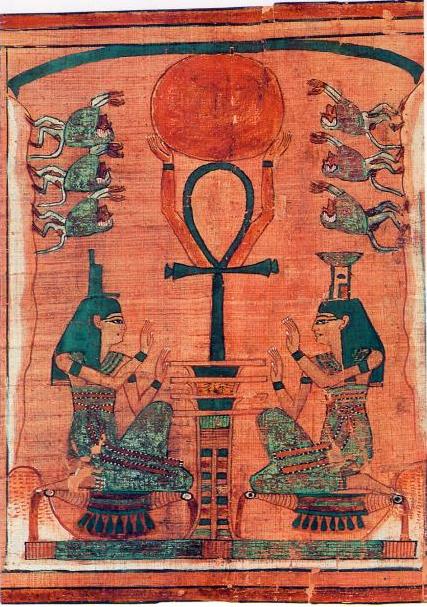
Painting of the veneration of the sun from ancient Egypt dated to 1,300 BC.
The Religion of the Sun is a religion that was widespread in ancient times in which the sun was venerated as the supreme manifestation of the divine.
Sun worship was common among the civilizations of the ancient world. It was practiced:
- in ancient Egypt
- by the Indo-Europeans, which include:
- the Celts and Druids
- the Vedic practitioners of India
- the Persians
- the Hittites
- the Minoans and Mycenaeans of Greece
- the Germanic and Slavic peoples
- among the megalith builders of Europe
- in Sumer
- by the Phoenicians
- by the mound builders and Pueblo people of North America
- by the Aztecs, Maya, and Inca
- and in many other traditions
By studying their beliefs and history, my husband and I realized that the religion of these ancient cultures was influenced by or derived from a common source. That source was the Religion of the Sun, which was spread to different parts of the world thousands of years ago by a seafaring civilization (this is explained further in the following answers). This religion is the reason why the same style of megaliths—like pyramids and standings stones that are aligned to the sun—are found across many parts of the world, and why the same or similar symbols (particularly those to do with the sun), legends, cultural artefacts, languages, and beliefs can also be found in all the places it spread.
The term “the Religion of the Sun” was first used by my husband and I (Mark and Lara Atwood) in 2016 to describe this religion, which we discovered and are piecing together through our research.
The Religion of the Sun was the most widespread religion in ancient times. It was one of the most powerful influencers on human history. It had a massive and profound influence on ancient religion (including Christianity) and upon the development of civilization.
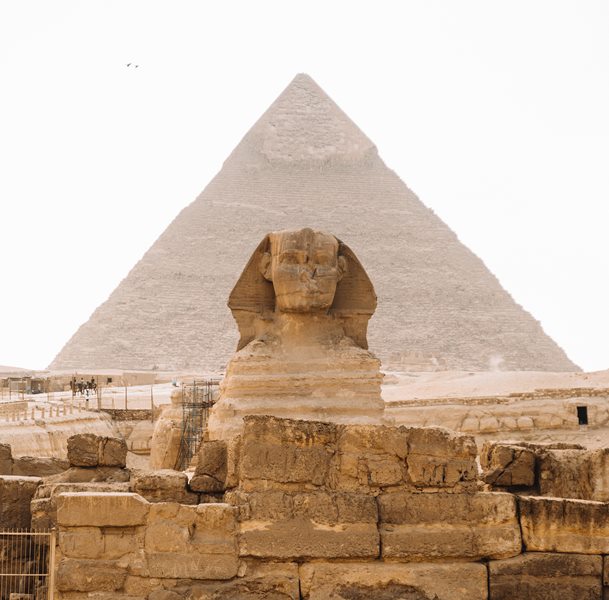
Records preserved in Egypt state that their ancient civilization and religion of the sun date as far back as about 40,000 BC. Photo by Alex Azabache on Unsplash
The short answer is—we don’t know. It’s at least thousands of years old, but could be tens of thousands of years old or more.
It has come down to us through a lineage of lost civilizations that were either destroyed through global catastrophes or collapsed, but its true origins are lost in the mists of time. We are left trying to work out how old it is by tracing the earliest evidence for it.
We find this evidence in ancient texts. The Religion of the Sun is described in the oldest religious texts in the world, like the Vedas of India, which date to at least 1,500 BC, and the Pyramid Texts of Egypt, which date to at least 2,400 BC. I say “at least” because these texts were based on much older traditions. For example, observations of astronomical positions that must have been made as far back as 10,000 BC have been identified in the Vedas. Visual depictions of stories from the Vedas have also been found carved onto the pillars of Göbekli Tepe—a megalithic site which is dated to around 10,000 BC. These finds reveal that the Vedas contain material that is at least 12,000 years old, which was passed down over thousands of years as part of an oral tradition before being committed to writing.
We also find evidence at ancient religious sites. There are hundreds, if not thousands, that are aligned to the sun at the solstices and equinoxes, which are the sun’s major turning points in the year—those that can be dated tell us how long ago people were worshiping the sun. The oldest known of these is the Lascaux cave complex in France which is famous for its beautiful artwork that was painted 17,000 years ago. The Lascaux caves were specially selected as a sacred place because they naturally align to the sun (although not enough is known about the beliefs of the people who made the artwork to say with any certainty whether they had been influenced by the Religion of the Sun). Sun shrines were built in Serbia at another site with a natural summer solstice alignment sometime between 11,500-9,200 years ago, likely as part of the Indo-European tradition of sun worship (which the Vedas belong to).
There are also indications that the Religion of the Sun originates even further back than these dates. Both ancient Egyptian and Indo-European traditions describe a distant “golden age” when their solar religions were first practiced. Ancient records kept in Egypt state that Egyptian civilization and religion date back as far as 42,000 years ago, and the archeological evidence of Indo-European sun worship possibly dates as far back as 12,000 years ago. Both Egyptian and Indo-European cultures state that their way of life and religion was a legacy handed down to them from a civilization destroyed by a global catastrophe.
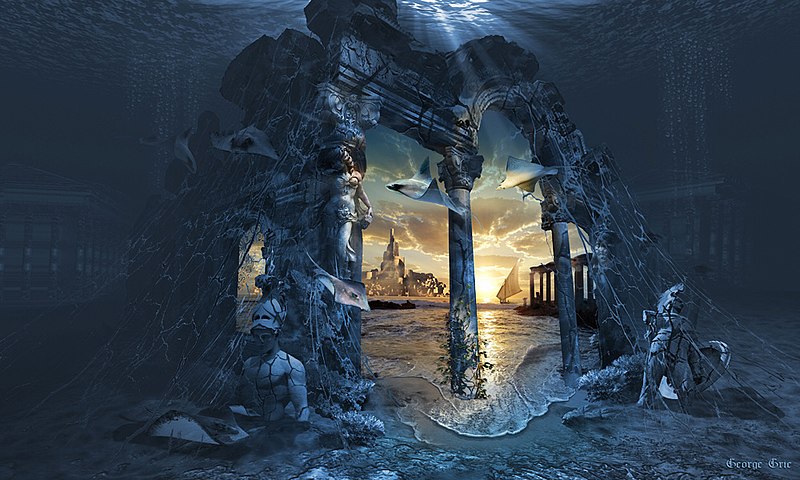
Artwork is Lost City of Atlantis by George Grie, CC BY-SA 4.0
According to numerous ancient legends (including those of a number of indigenous peoples of the Americas), the Religion of the Sun was first practiced among the people of a now lost civilization that was destroyed by a great flood.
These people were described as god-like, were often said to have been giant in stature, and became known as gods in many cultures—such as the Ennead in ancient Egypt, the Annunaki in Mesopotamia, the Nephilim of the Bible, and the Titans of Greek mythology. They were said to have worshiped the sun and maintained an advanced and peaceful civilization over a long period of time. Various legends state, however, that they interbred with other humanoids, lost their spiritual qualities, and became arrogant, and that they and their civilization were destroyed in a global cataclysm as a result. The account of Atlantis is a version of this legend. The date given for its destruction coincides with the huge Earth changes that ended the Ice Age at around 9,700 BC. The sudden and massive rise in sea levels that occurred at the end of the Ice Age is the most likely source of the legends of the great flood that destroyed this civilization.
Priests/sages of the Religion of the Sun, who were descendants of this former race and who survived the cataclysm, then embarked upon a mission to re-establish civilization and the Religion of the Sun among indigenous people in different parts of the world. I refer to these priests/sages as “the wisdom bringers.” Over time these wisdom bringers were also mythologized and became known as gods. Examples include Viracocha of the Inca, Quetzalcoatl of the Aztecs, Masaaw of the Hopi, Manu of India, and Osiris of Egypt. The ancient legends about them reveal, however, that these were real people, not just myths.
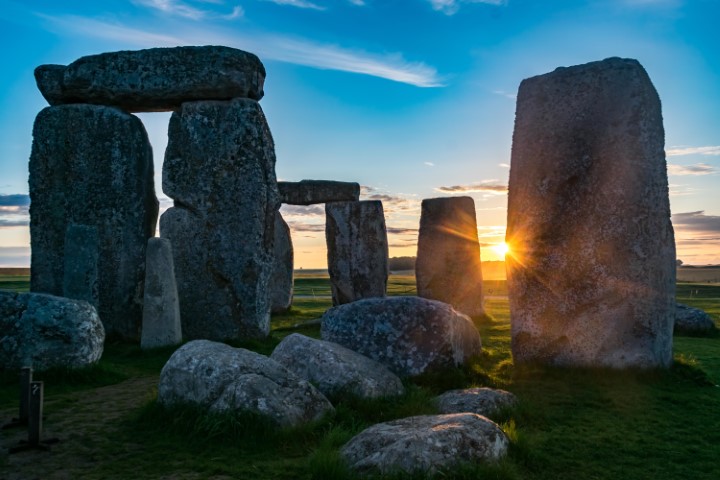
The ancient site of Stonehenge, which was aligned to the solstices and used for the veneration of the sun. Photo by Ankit Sood on Unsplash
Most think that sun worship arose out of the instinctual impulse of primitive people to make gods out of those things important to their survival. However, ancient texts clearly describe that the sun was venerated for a much more profound reason, which had to do with the spiritual nature of light.
Light was seen as the greatest visible manifestation of the divine. As the sun is the greatest source of light we can see, it was venerated as the outpouring of the divine in the material world, which ultimately had its source in an invisible, supreme creator.
This is what the ancients tell us in their traditions and texts, all the way from the Native Americans, to the pharaohs of Egypt, the yogis of India, and the pagans of Europe. Each of them state that the sun is the visible part of an otherwise invisible supreme godhead who is the creator and source of all life.
There are beautiful hymns and songs that are hundreds and even thousands of years old that describe how ancient peoples saw the sun, and these are still treasured as some of the most sacred religious texts in the world today. For example, in ancient Hindu texts of India, the sun is called the Lord of Love, the eternal Self, the Godhead, and supreme Being. Yet it’s made clear that the sun is just the creator’s visible manifestation. He/It is said to be beyond the sun as its origin. He/It is described as filling the whole cosmos and yet as transcending it at the same time, as infinite and indescribable.
The practitioners of the Religion of the Sun aligned their ancient sites to the sun as they wanted to incorporate its light into the very place where they were worshiping. They were trying to commune with the divine and get as close to it as they could.
Scientifically, it’s said that everything we see is made of the stuff of stars, and many ancient peoples also recognized this. In fact, the main theory of how the universe came into existence was through the Big Bang, which appeared as a burst of light. A number of ancient texts echo this in their creation stories by saying that in the beginning the first thing that happened was that light came into the darkness, and that everything in existence came from the light.

A reed boat built according to ancient designs that sailed from the coast of South America to Easter Island in 2003, proving that the sun worshiping civilizations of the Americas and Easter Island could have been connected. The expedition was led by Phil Buck who was inspired by similar expeditions made by Thor Heyerdahl. Photo by Valentinapazmunozmarquez CC-BY-SA-4.0
The spread of the Religion of the Sun was initiated by a number of great sages, who traveled the world with the mission to re-establish religion and civilization after a great flood. They became remembered as gods among many native peoples; I call them the “wisdom bringers.”
From what they established, a global, seafaring civilization arose, which followed the Religion of the Sun and further spread it across the world over thousands of years. I call this civilization “the Lost Civilization of the Sun.” It existed from the end of the last ice age around 9,700 BC, until the centuries around 1 AD when it collapsed due to the expansion of the Roman Empire and its conquest of the Mediterranean and parts of Europe. Remnants of it survived in remote places up until around 500 to 300 years ago when the Spanish conquered the New World.
Although it’s generally believed that ancient people did not have the ability to cross oceans in any significant way before Columbus in 1492, there’s plenty of evidence they did, and that the oceans were busy with migration and trade. Modern expeditions, such as those undertaken by Thor Heyerdahl, have used reconstructions of ancient ships to prove ancient people could have traversed the oceans, and even solitary rowers have made these ocean crossings in recent times.
I liken the spread of Lost Civilization of the Sun to that of Western civilization. Although Western civilization has been comprised of many different kingdoms and nations over long periods of time—some who even fought devastating wars against one another, speak different (though related) languages, and have quite distinct cultures—all Western cultures derived from Europe and adopted and spread the same ideas, institutions, and religion, which became part of a global network of trade and migration.
Likewise, the Lost Civilization of the Sun comprised of tribes, kingdoms, and empires spanning thousands of years over a vast geographical area, which essentially shared the same religious beliefs, cultural foundation, political system, and customs. The existence of this civilization explains why the same styles of ancient megalithic sites, symbols, cultural artefacts, languages, myths, and genes are found in disparate parts of the world, and it also explains how the Religion of the Sun spread.

Sun worship finally ended with the spread of Christianity, but many of its symbols and celebrations were subsumed by the Church. Photo by TheRedBaron93 CC-BY-SA-4.0
Because it was so widespread, the Religion of the Sun died out in different places at different times. Wars, conquest, and genocide led to the eventual collapse of the Lost Civilization of the Sun that had spread it across the world, and to those cultures and peoples who followed it.
The knowledge of its deeper principles was also lost over time, even though the outward worship of the sun continued. This occurred because the cultures with wisdom traditions that preserved this knowledge were invaded, replaced, displaced, assimilated, or degenerated. The connection with the long held spiritual wisdom of the past was severed, and the focus of the religion became increasingly mundane.
The almost total end for the Religion of the Sun began, however, when the Roman Empire adopted Christianity as its state religion. Formerly sun worship had been the Roman state religion as it had been in so many civilizations of the ancient world. With the spread of Christianity over the approximately one thousand years that followed its adoption by Rome to places like Europe and the Americas, the former traditions of sun worship were almost completely annihilated. Vestiges of the Religion of the Sun, however, can still be found in Christianity. For example, Christmas, which is the celebration of the birth of Jesus, is timed with the winter solstice (in the northern hemisphere), which is when the sun is reborn after the darkness of winter.
It survived the longest in some of the most remote parts of the world, like Easter Island and the Canary Islands, up until approximately 300 to 500 years ago, when they were Christianized.
In other places though, it never totally died out. In India, which was never Christianized, aspects of it continue today just as in ancient times. Because of this, India is the place where the beliefs of the Religion of the Sun are most fully preserved. Among certain communities, like the Yazidis of the Middle East, which have survived thousands of years, it has also partially carried through until today.
Despite being suppressed for centuries in places like Europe and the Americas it’s now making a comeback as people reconnect with their indigenous traditions.
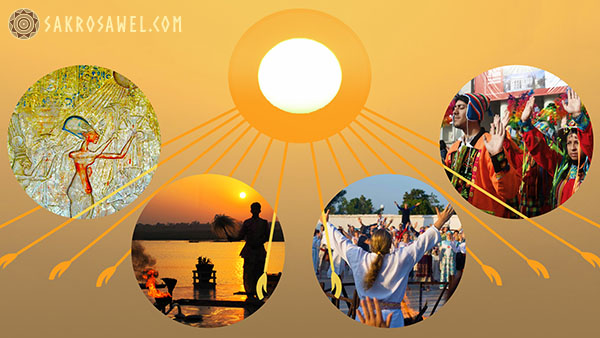
Images: Aten CC BY-SA 3.0 by AtonX, Akhenaton CC BY 2.0 by Jean-Pierre Dalbéra, Aarti CC BY-SA 2.0 by jeminichronicles, Ukraine CC BY 2.0 by Yuri Samson, Inti Raymi CC BY-SA 4.0 by Jisa39
There are numerous traditions that derive from or were influenced in some way by the Religion of the Sun, many of which have survived to this day or are being revived. They include:
- All Indo-European traditions, including:
- Vedic religion/Hinduism
- Zoroastrianism
- Armenian, Scythian, Hittite, Germanic, Nordic, Baltic, Slavic, Thracian, Greek (Hellenic and Minoan), Roman, Celtic and Druid religions
- Megalith and passage mound builders of Europe
- Ancient Egyptians
- Ancient Libyans/North Africans
- Sumerians
- Yazidis
- Mandaeans
- Phoenicians
- Guanches of the Canary Islands
- Ancient Chinese
- Ancient Japanese
- Khmer
- Stone builders and mound builders of North America
- Pueblo peoples including the Hopi and Zuni
- Aztecs, Maya, Inca, and Toltecs, among many other cultures of Central and South America
- The culture of Easter Island
Our research indicates that Jesus also essentially taught the Religion of the Sun, but most of his teachings were excluded from the Bible and were banned and lost as a consequence. Some of these lost teachings have only resurfaced in the last few decades. They are described by academics as “Gnostic” and include ancient texts like those in the Nag Hammadi Library, which clearly contain themes from the Religion of the Sun that are also found in the Eleusinian Mysteries of Greece, Zoroastrianism, Hinduism, and ancient Egyptian religion.
With the advent of Christianity, some of the practitioners of the traditions that were derived from the Religion of the Sun continued to follow it in secret, preserving some of its knowledge, but often hiding it using symbols. Thus, its influence can be seen in a number of secret orders in Europe, including the Knights Templar, Freemasons, and Rosicrucians.
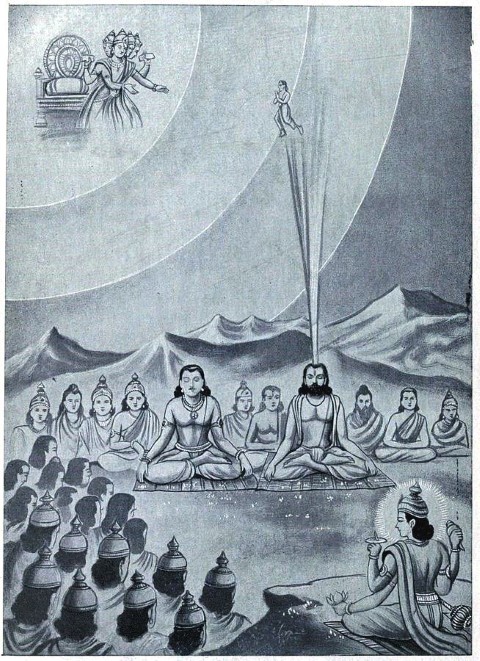
In the Vedic texts of India, the aim of the religion is to reunite with one’s higher being, called Atman, who is said to be part of the source of creation and is identified with the sun. Here, one of the founding kings of ancient India ascends to the heavenly regions of the sun.
The Religion of the Sun had a comprehensive theology and cosmology, which answered all the questions normally addressed by religions today, such as:
- What is the purpose of life?
- What happens after death?
- Is there a creator/god?
- How can people come closer to the divine?
- Is there more to life than what we can see?
- Why is there suffering?
- Are there consequences for either good or bad actions?
The aim of a practitioner of the Religion of the Sun was to become an immortal being of light, who lived after physical death in the higher realms that exist in the region of the sun and stars. As such, the Religion of the Sun was focused on the transformation of the individual and their journey to return to divinity. And while there was an upper, heavenly realm associated with the sun, there was also an underworld where those who had acted badly went after death, which practitioners sought to avoid.
There were many rituals and spiritual techniques that were developed in various traditions over a long expanse of time to achieve the aims of the Religion of the Sun, yet among them were certain key principles. Central to its practice was the inner purification of desires/egos, good conduct, selflessness, monogamous marriage, the sacred use of sex, and the development of love and compassion.
In seeking the afterlife realms of light, worshipers sought to follow in the path of the sun. Religious rituals and ceremonies which emulated this path aided lay people, while initiatory schools were for those who were more committed, in which the pattern of initiation correlated with the sun’s annual journey through the sky. The events in the life of numerous sun gods also encoded this path, which is one of the reasons they share so many similarities in their characteristics and lives.
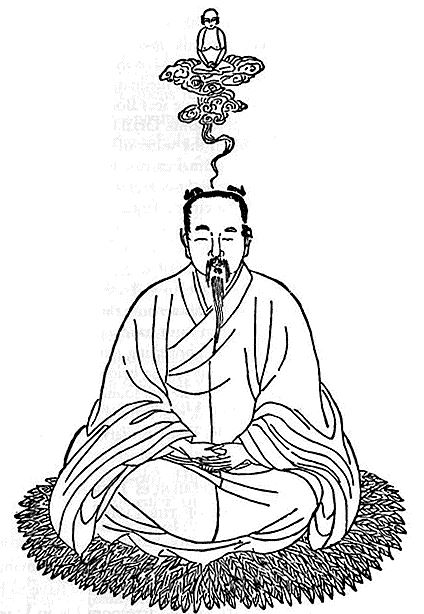
Spiritual experience has always been at the heart of the Religion of the Sun. Illustration is from an old Chinese Taoist text.
There are two ways to find out.
One is through research into their ancient texts, sites, beliefs, and cultures.
The other is through practicing the same spiritual techniques, and going through the same spiritual processes they did. These exercises are currently being researched and applied, and as they are, more is being revealed about what their ancient practitioners believed. This is because a spiritual practice will give more or less the same result when it’s repeated, and we know that result can be the same in ten years’ time, for example. So it could be inferred that practicing techniques that are even thousands of years old will give the same result now. For instance, types of meditation were described as leading to a sense of connectedness with the divine; when practiced, they invoke the same sense today.
The Religion of the Sun is being reconstructed by combining methods based both in practice and research.
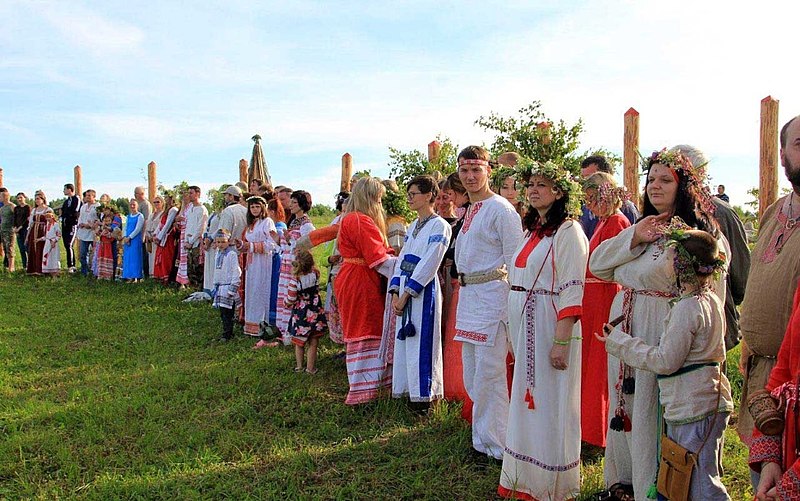
Celebration of the summer solstice in Russia. Celebrating these times of year according to their spiritual meaning is a common practice of the Religion of the Sun. Photo by Union of Slavic Rodnover Communities (Союз Славянских Общин Славянской Родной Веры) CC-BY-SA-4.0
Yes, I’m currently researching its theology and ancient practices in order to reconstruct them so they can be practiced again.
Its practices are often simple, and most can either be done with others or by oneself. They include rituals, prayers, mantras, meditation, visualizations, and breathing exercises, which have been used for thousands of years. Many of these practices are still used by millions of religious practitioners today.
These practices are either found described in ancient texts or have been reconstructed based on historical accounts and archeology. For example, my husband has recreated ancient solstice and equinox ceremonies using sacred texts, mythology, cultural artefacts, and the symbology of ancient sites. These celebrations allow people to conduct ceremonies similar to those conducted by ancient people, with an understanding of their deeper meaning relevant to today.
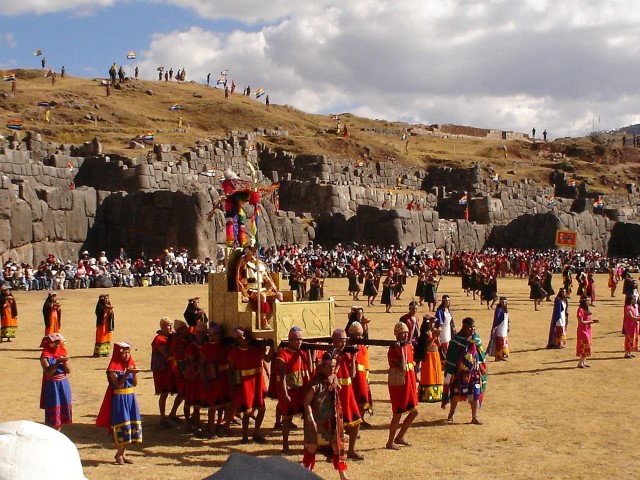
Thousands celebrate the winter solstice called Inti Raymi, meaning “festival of the sun,” at the ancient site of Sacsayhuaman, Cusco, in Peru, based on how it was celebrated by the Inca. Photo by Cyntia Motta CC-BY-SA-3.0
Research is currently underway to reconstruct how it was practiced. So far, we have written two books on its practice: Ancient Solstice and The Spiritual Out-of-Body Experience, and are working on more.
We’ve identified that the winter and summer solstices, and spring and autumn equinoxes were the main times of religious celebration. This is detailed in my husband’s book (which I helped co-author) Ancient Solstice and in a four part video series I made. We discovered that these celebrations, though found in different cultures, often share central themes, which correlate with the path of the sun and its major annual turning points. The relationship between light and darkness, and the cycles of the earth and sun, were seen as expressing truths not only about creation, but the journey of each one’s soul through it.
For example, in nature the autumn equinox is a time of encroaching darkness and death. In ancient ceremonies, this was used to symbolize the darkness each carries within, of hatred, greed, anger, etc. It was only by facing and overcoming this darkness that someone could realize their inner light. Darkness was identified with a great goddess, who was the feminine matrix of creation, and was therefore appealed to for removing the darkness within. This ancient practice is most vividly preserved in the celebration of Durga Puja in India held at the autumn equinox.
We can therefore say that celebrating the solstices and equinoxes according to their deeper meaning as it relates to the journey of the soul, was a key practice in the ancient Religion of the Sun. In Ancient Solstice we have reconstructed example ceremonies for these times of year from different ancient cultures, and have provided a guide for people to construct ceremonies themselves based their own culture with an understanding of their ancient meaning.
We’ve also discovered that dreams were an important source of spiritual guidance, as they were thought to be a way through which spiritual beings in higher worlds communicated with people. Many ancient people sought to interpret their dreams using specialized dream interpreters and dream symbol books. Examples of this are found in ancient Egypt, and a number of other ancient cultures. People particularly sought to receive spiritual guidance and assistance through the practice of dream incubation, which was a popular practice in the ancient world – there even being temples dedicated to it, like in ancient Greece.
Having out-of-body experiences, either by lucid dreaming, but especially through astral projection, was another key practice, though one that was kept secret. We now have knowledge of this practice through the discovery of what were once hidden texts intended only for religious teachers and their students.
In our book The Spiritual Out-of-Body Experience, we detail the use of dreams and out-of-body experiences in ancient traditions and cultures of the Religion of the Sun. We reconstruct many of these ancient practices, including a ritual for dream incubation, and techniques for astral projection.
What makes the Religion of the Sun so unique is that because it was so widespread and is part of the cultural heritage of so many different and diverse peoples throughout the world, someone can choose to practice it through their own ancestral tradition. So, for example, someone who is ethnically from India can practice it through the iconography and knowledge preserved in Hinduism. While another who is ethnically from the Andes region of South America can practice it through that of the Inca. And an indigenous pre-Saxon Briton can practice it through that of the Celts of Europe or the more ancient megalith builders, and so on.
The Religion of the Sun offers a way to practice ancient religion, while celebrating and preserving the diversity of human culture, ethnicity, expression, and creativity.
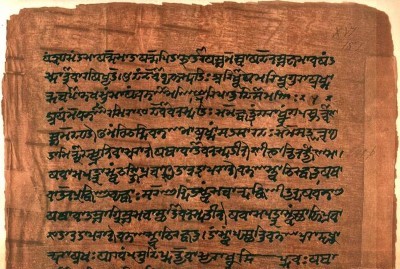
A page from the Atharva Veda, which is one of the four books referred to as the Vedas. It preserves knowledge from the Religion of the Sun.
There is no single body of ancient literature that someone can point to and say “these are the sacred texts of the Religion of the Sun.” Instead, its spiritual knowledge and practices are partially preserved in scattered written remnants from traditions that were derived from or influenced by it. These include the most ancient sacred texts in the world, which are the Vedas of India and the Pyramid Texts of Egypt. Other texts include the Bhagavad Gita, the Egyptian Book of Emerging Forth into the Light (commonly known as the Book of the Dead), the Tao Te Ching, the Corpus Hermeticum, and the Nag Hammadi Library, but there are many more.
It was also partially preserved in oral traditions that are thousands of years old, like those of the indigenous peoples of America. Some of these traditions were eventually written down and they also form a guide to the beliefs and history of the Religion of the Sun.
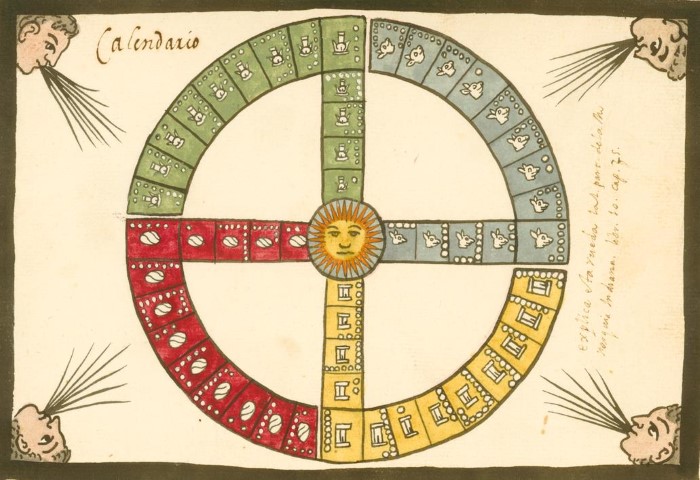
Depiction of the solstices and equinoxes from an Aztec codex.
There are four main holy days in the year for practitioners of the Religion of the Sun, which are the autumn equinox, winter solstice, spring equinox, and summer solstice. These are the key transitions in the earth’s annual orbit around the sun. They were seen as highly symbolic of a spiritual journey one could take to return to the heavenly regions of light. They were the most celebrated religious days in ancient times, and they remain so today. For example, Christmas occurs at the winter solstice (in the northern hemisphere), which is celebrated by over two billion people, while the winter solstice itself is celebrated by millions of Hindus, and by thousands (possibly tens of thousands) of pagans in Europe and the Americas.
Sundays were also considered holy in some traditions, as the name suggests—being the day of the sun.
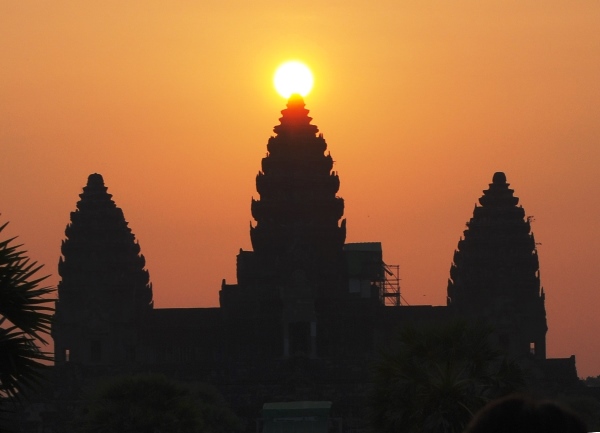
The ancient temple of Angkor Wat in Cambodia, which is aligned to the rising sun on the equinox. Photo by សុខគឹមហេង CC-BY-SA-3.0
There are hundreds, perhaps even thousands of ancient sites across large parts of the world that were built and/or used by people who practiced the Religion of the Sun in some way. Many of these sites can still be visited today. These sites were aligned to the sun at the solstices and equinoxes, which are the most celebrated days of the religion, and include ancient cities, temples, pyramids, mounds, standing stones, dolmens, and natural formations which were held sacred because of their solar alignments. There were also many sacred sites and groves which have since been lost or destroyed.
Remaining sacred places include some of the most famous, enigmatic, and technically advanced ancient sites on the planet, such as the Great Pyramids and Sphinx of Egypt, Stonehenge, Newgrange, Easter Island, Machu Picchu, the cities of Petra and Chaco Canyon, the Pyramid of the Sun at Teotihuacan and many more.
Practitioners reviving their ancestral practices have begun to use these ancient sites for their ceremonies. For example, thousands gather at places like Stonehenge in England and Cusco in Peru at the solstices to watch the recreation of ancient ceremonies. Some practitioners are also creating their own sacred places based on ancient practices from their cultures. For example, some in the Slavic tradition have built wooden temples and outdoor standing circles based on ancient designs.

A ritual offering called a yajna made to the sun god Vishnu in India. Only flowers and vegetarian foods are used as decreed in a number of texts. Photo by Biswarup Ganguly CC-BY-3.0
Evidence reveals that neither human nor animal sacrifice was part of the Religion of the Sun originally, but that these practices were introduced later as its principles were lost and the religion degenerated or was corrupted by outside influences. In the Religion of the Sun, human and animal sacrifice was seen as completely abhorrent and was outlawed by some of its greatest teachers.
Unfortunately, some cultures that inherited aspects of the Religion of the Sun practiced human sacrifice, even in complete contradiction to the guidance given by the teachers they venerated. For example, human sacrifice was particularly associated with sun worship among the Aztecs. Yet the great wisdom bringer worshiped by the Aztecs called Quetzalcoatl—who was remembered as teaching sun worship in Mexico—was said to have forbade the sacrifice of all living beings and instructed that only flowers and fruits should be offered upon altars.
The Aztecs are just one of many cultures that followed aspects of the Religion of the Sun but also practiced human or animal sacrifice, at odds with the original religion.
Like Quetzalcoatl, both Jesus and Osiris (of Egypt) were also recorded as forbidding animal and human sacrifice.
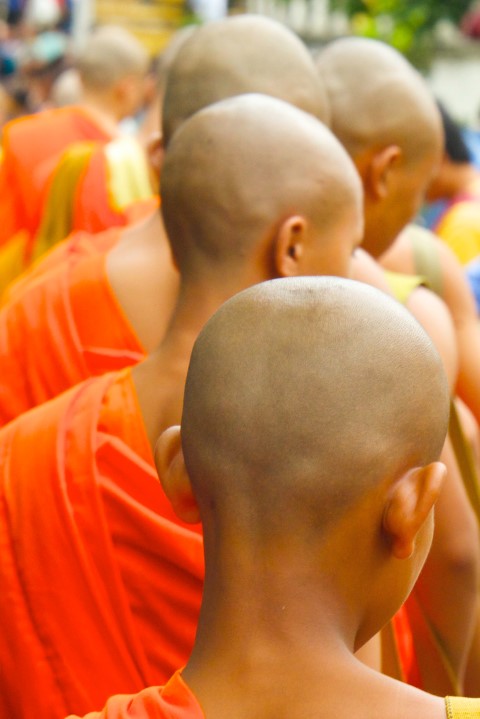
Buddhism is distantly related to the Religion of the Sun, but took its own course away from it. Photo by chrissie kremer on Unsplash
No—there were and are many other religions in the world that are not related to the Religion of the Sun. These include many tribal religions, shamanism, religions that were practiced by hunter-gatherers during the Ice Age, and new religions today.
It is also fundamentally different to the major religions of Judaism, Islam, Buddhism, and Christianity.
Judaism seems to have been somewhat influenced by the Religion of the Sun in its early texts, however, it is very different to it. For example, the First Temple of Jerusalem built by Solomon (the most important site in Judaism) is described as having been dedicated to sun worship. Later, Josiah, the 16th king of Judah, was said to have eradicated sun worship from the temple, and this appears to be one of the events that set Judaism apart from the Religion of the Sun.
Islam is based on this Judaic tradition and thus is not related to the Religion of the Sun either.
Buddhism derived from Hinduism, and because of this contains some of the ancient knowledge from the Religion of the Sun, but diverged from it. Most significantly, Buddhism espouses that there is no God or supreme being, which is fundamentally different to the Religion of the Sun that holds there is an intelligent, loving, and omnipotent creator/source, which is the Spiritual Sun—the spiritual source of the light that shines physically from the sun.
Christianity shares some similarities with the Religion of the Sun because it contains some of the teachings of Jesus, who taught principles found in the Religion of the Sun, and whose life events correlate with what we call the path of the Spiritual Sun. However, the Christian religion is largely based on the teachings of Paul, which differ in key ways to those of Jesus, and this is what has made Christianity different from the Religion of the Sun.
Texts of the Religion of the Sun do not espouse that all religions are one, or that all lead to enlightenment/salvation—instead they are firmly rooted in their own doctrine and identity.
If the Religion of the Sun Is Found in So Many Ancient Cultures, Then Why Are They All So Different?
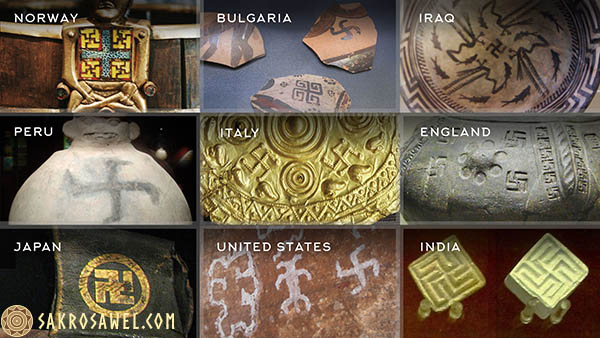
The symbol of the swastika can be found all over the world. The earliest known example of it was found in Ukraine carved onto the tusk of a woolly mammoth, and dated to around 10,000 BC. Photo credits: Norway CC BY-SA 3.0 by Thorguds, Bulgaria GNU Free Documentation License, Version 1.2, Cristian Chirita, Iraq CC BY-SA 4.0 by Dbachmann, Peru public domain, Italy CC BY-SA 3.0 by PHGCOM, England public domain, Japan CC BY-SA 3.0 by Шнапс, United States CC BY-SA 3.0 by Tylas at English Wikipedia, India CC BY-SA 3.0 by Before My Ken
There are differences between the ancient traditions that derived from the Religion of the Sun. Yet to the keen observer who knows what to look for, there are also key similarities not easily identified at first glance, as they became veiled by local forms of expression.
Some of these differences are only skin deep, like those between Indo-European traditions. For example, as Indo-European peoples branched off from one another over time, each developed their own unique characteristics and languages. Yet scholars have been able to identify their common roots. Just as they developed different but related words to describe the same thing, they developed different names for and ways of portraying the same god or principle. One of the most obvious examples of this is the god who symbolized thunder. In the Proto-Indo-European language and religion, from which all Indo-European traditions derive, this god was known as Perkwunos. In Slavic tradition he became known as Perun, in India as Indra, in Greece as Zeus, and Northern Europe as Thor, yet despite the different names, they are all at least partly based on the same figure.
Differences also arose because some of these cultures were separated over such a long period of time that they each continued to develop their own beliefs independently. In other cases, cultures already had their own beliefs, but adopted some aspects of the Religion of the Sun, merging them together.
All the cultures that came into contact with the Religion of the Sun had their own unique forms of art, and thus expressed the same religious beliefs and symbols according to their own style, which they also did by using the native animals and plants of their surrounding environment. For example, one of the main symbols of the Religion of the Sun, the world tree, was symbolized by a cedar in ancient Egypt, an ash in Northern Europe, and a Ceiba in Central America—yet all expressed the same underlying belief. In other cases, symbols of the Religion of the Sun are clearly identifiable in disparate cultures—such as the swastika, which appears in the Americas, Asia, Africa, Mesopotamia, and Europe.
One of the reasons more of these similarities have not been identified is because of the way academia works by compartmentalizing fields of study and then specializing in them. This isolationist approach makes it very difficult to see the similarities between cultures.
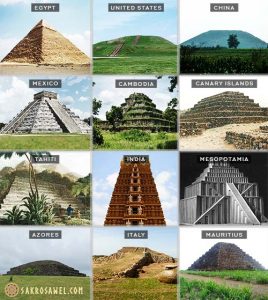
Pyramids of similar design have been found all over the world, and have led many researchers to conclude that the ancient civilizations who built them must have derived from a common source. All of them were built as part of a religion in which the sun was central. Image credits: Egypt CC BY 2.0 by Jerome Bon, United States CC-BY-SA-3.0 by Skubasteve834, China public domain, Mexico CC BY-SA 4.0 by Daniel Schwen, Cambodia public domain, Canary Islands CC BY-SA 3.0 by Pedro ximenez, Tahiti public domain, India CC BY-SA 4.0 by MADHURANTHAKAN JAGADEESAN, Mesopotamia public domain, Azores CC BY-SA 4.0 by Torbenbrinker, Italy CC BY-SA 3.0 by Gianf84 at Italian Wikipedia, Mauritius CC BY-SA 4.0 by Uli sh
The existence of ancient solar religions is well known to academia—there are reams of evidence for ancient sun worship in texts, sites, traditions, and archeological finds, which have been studied by countless scholars.
For example, it is well known that the religion of the Indo-Europeans was solar in nature and that it is the origin of a vast set of religious traditions which branched off from it. It is also well known that the religions of Mesoamerica and ancient Egypt were solar.
As for the connections between solar religions, the Norwegian adventurer Thor Heyerdahl identified sun worship as one of the major traits shared by the civilizations of the ancient world, which along with much other evidence, led him to conclude that they had been in contact with and influenced one another. He proved they had the ability to cross the oceans, and thus this contact was possible, by crossing the Atlantic and Pacific himself in reconstructions of ancient boats.
Dr David Frawley, founder of the American Institute for Vedic Studies, also identified solar religion as the earliest religion of mankind and believes it is most completely and accurately preserved in the Vedic religion of India (a position I agree with).
Other researchers, such as Graham Hancock and Randal Carlson, have suspected that a common thread weaves the civilizations of the ancient world together, and numerous academics and researchers have documented the clear connections between a number of ancient cultures, even those that were separated by oceans.
A few writers and researchers—such as the 33rd Degree Freemason and prolific occult writer Manly P. Hall, and one of the Founding Fathers of the United States (and possibly a Freemason), Thomas Paine—have concluded that a shared religion centered on sun worship is at the root of many ancient traditions.
However, as far as I’m aware, my book The Ancient Religion of the Sun is the first to attempt to write a history of this religion. It brings together the evidence that reveals how ancient forms of sun worship derived from the same religion, and also demonstrates how this religion spread, and who spread it, providing a comprehensive history. In the book I cite the work of numerous academics and researchers across multiple fields, like linguistics, genetics, archeology, and theology, as well as ancient texts and indigenous oral histories, in over 1,300 references.
And, as far as I’m aware, my husband’s book Ancient Solstice is the first attempt to reconstruct the theology of the Religion of the Sun, using ancient sites, texts, and traditions.
